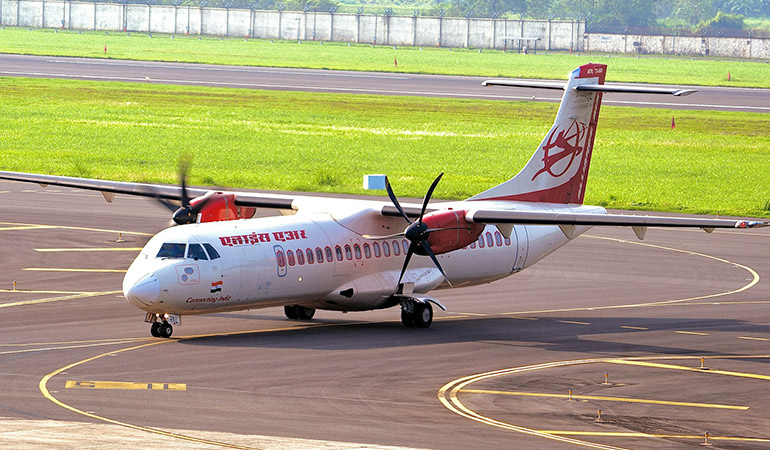Current Trends in Indian Aviation
The civil aviation industry in India is thriving. The domestic air traffic moved 37.6 crore passengers in FY2024 and is expected to nearly double by 2030. India is already the third-largest domestic aviation market in the world. Fleet growth and infrastructure are also in equilibrium: over 2,000 new aircraft are on order, and the number of operating airports has increased, to 74 in 2014 and 157 in 2024. By 2047, the government has a plan to have 350-400 airports. The growth is creating waves of demand, whether in pilots and engineers, cabin crew and ground crew, as airlines and airports fight to provide routes and services.
Key Government Schemes: UDAN and Airports
The Indian government came up with huge schemes to fuel this growth. UDAN (Regional Connectivity) scheme has enabled subsidized flights to smaller cities: over 583 UDAN routes have been launched to 86 regional airports (including remote heliports), to over 1.4 crore passengers. The UDAN was to be covered in 120+ locations by 2024. At the same time, dozens of new airports are emerging. Greenfield projects such as Navi Mumbai and Jewar (Noida) are being built, and the government has allocated a budget of 91,000 crore to build 50 new airports over the next few years. Indeed, 12 new greenfield airports have already been opened since 2014, and numerous more are being upgraded. All these initiatives, UDAN, airport modernization, and connectivity initiatives, are directly generating employment in the airline and airport operations in India.
Increased Demand for Aviation Professionals
The boom in growth has spurred a recruitment boom for top aviation positions:
Pilots: India needs tens of thousands of new pilots. According to the government estimates, there will be 30,000-34,000 new pilots in 2040. Boeing predicts that South Asia will need an estimated 37,000 pilots by 2042 as fleets expand. There will be a demand of 674,000 new pilots globally in the next 20 years, according to Boeing.
Cabin Crew: The airlines are also recruiting very hard. Indian figures are precise, but the international industry estimates almost 980,000 new cabin crew in the 2040s. The airlines of India will eat a very large portion of that demand as it increase its flights and aircraft.
Maintenance Engineers (AMEs/Technicians): Maintenance of aircraft is another growth area. The Maintenance, Repair, and Overhaul (MRO) sector in India is expanding (96 facilities in 2014 to 154 today), and Boeing predicts 710,000 new maintenance technicians worldwide by 2044 (about 45,000 in South Asia). These include the licensed Aircraft Maintenance Engineers (AMEs), avionics technicians, and support.
Drone Pilots: The Unmanned Aerial Vehicle (UAV) market is hot. The DGCA emphasized the fact that India would need over 100,000 drone pilot certifications by 2023; current figures (~24,000 registered pilots) are nowhere near the required amount. Today, drones are applied in agriculture, mapping, surveillance, and delivery, and every drone operation requires a trained pilot and support crew. There are ~1 million drones that may be in use in India by 2027.)
Airport Ground Staff: New routes and new airports translate into an increase in jobs in ground handling, customer service, ramp, and security. As new airports and new flights are opened, professions such as check-in agents, baggage handlers, and air traffic controllers are in greater demand too. Industry experts point out a looming shortage of airport and airline personnel unless training levels are maintained pace.
Overall, the functions of both airports and airlines are increasing. Airlines report that they are aggressively recruiting pilots, crew, and engineers to deal with this growing demand. Aviation students who will begin their careers in the future will have an enormous scope of career prospects.
Technology and Innovation in Aviation
New technology is changing the face of aviation careers. India is going in for AI, automation, and digital technologies in airports and in the skies. For example, the Digi Yatra biometric boarding system has been introduced for hassle-free paperless travel, while the Mumbai Airport has installed smart e-gates recently for touchless passenger movement. On the ground, airports are installing automated baggage systems, AI-driven security screening, and remote “digital” control towers that use high-definition cameras and AI to monitor runways. In the air, airlines are using advanced flight simulators, predictive maintenance (sensors/AI that can detect things before they fail), and AI-powered scheduling and navigation tools.
The very drones are an example of tech innovation: the drone industry in India was about 1.15 billion in 2024 and growing at approximately 20 percent per annum. A FICCI-EY report forecasts that India will have a drone manufacturing and services worth $23 billion by 2030. Farming, logistics, and disaster response (even on the battlefield) are using AI-powered UAVs. All this comes with new high-tech employment: drone operators and engineers, AI data scientists, aircraft software developers, and cybersecurity experts, among others.
The students are therefore expected to acquire aeronautical expertise and current technological skills. Computer systems and data science knowledge, IT/AI ideas will come in handy. Soft skills of problem-solving and flexibility are also necessary since technology will continue to change operations. Overall, new aviation professions will mix old professions (pilots, engineers, crew) with new computer skills.
Expansion of Regional Airlines and New Hubs
The aviation development of India is not restricted to the large cities. Connectivity to Tier-2 and Tier-3 cities is being pushed by airline and government efforts. Local hubs are being developed in new airport developments (e.g., at Mangalore, Gondia, Darbhanga, etc.), and regional airlines (e.g., Star Air, TruJet, Alliance Air) are starting services between smaller cities. This decentralization means that the aviation industry will have jobs in smaller cities. As a matter of fact, the government notes that the shortage of skilled manpower is often more severe in the Tier-2/3 regions, which hold massive job prospects. As an example, new regional airports employ local pilots, ground handlers, and maintenance workers frequently. Small-town candidates are thus able to enter the aviation career field without relocating to the big cities. Local training at facilities like IGI can lead to direct local employment.
To capitalize on such opportunities, students need to concentrate on the proper preparation:
Pilot Path: Physical well-being and high-school grades (especially science) are needed. Join a DGCA-approved flight school to obtain your Commercial Pilot License (min 200 hours of flying). Combined courses or airline cadet schemes are to be taken into consideration. Sharpening in mathematics/physics and communication (fluency in English is a requirement).
Engineering/AME Track: Maintenance engineers should pursue a B.Tech in Aeronautical Engineering or a DGCA-approved AME diploma/degree. Gain practical skills by working as an intern or training at MRO centers. The most important skills are technical and analytical skills.
Cabin Crew & Ground Staff: Hospitality management or aviation certificate courses (with a focus on airline etiquette, safety procedures, and customer service) will help. Communication skills in stress, grooming, and dealing with the masses. English and a professional attitude are mandatory in the cabin crew and airport staff jobs.
Drone Operator: Enroll in a drone training program that is certified by DGCA. Students are to be certified as remote pilots by DGCA and get proficient in UAV technology and regulations. It is an added advantage to have technical studies in computer science or electronics.
Soft Skills: Teamwork, situational awareness, and flexibility are key in all the courses. The airlines and the airports give preference to safety-oriented, communicative, and disciplined applicants. Students can have a competitive edge in personality development and interview skills preparation (which IGI specializes in).
Stay Current: The aviation industry is changing at a fast pace. Be aware of industry trends and be informed of new technologies (e.g., avionics AI, green aviation technologies). Visit seminars, workshops, or summer schools. Courses offered by IATA or DGCA ratings can be used to improve credentials.
IGI Courses and Opportunities
The Indian Group of Institutions (IGI) has courses aligned to such industry requirements. For instance, IGI offers Pilot Training and B.Tech in Aeronautical & AME, training students to be licensed pilots and aircraft engineers – exactly the positions with the most demand. IGI Cabin Crew (Air Hostess) and Ground Staff courses equip students with front-line airline and airport industry jobs by training in safety, etiquette, and customer service. Other IGI programs include a BBA in Aviation, Air Ticketing (with GDS systems), Logistics & Supply Chain, and Travel & Tourism programs, all of which are in step with the emerging aviation and travel industries. To sum up, many IGI courses (ranging from realistic flight simulators and aviation hospitality training) follow the above-mentioned career paths and forecasts, allowing students to gain the certifications that companies require.
To explore the academic paths in detail, read our Best Aviation Courses After 12th guide.
Conclusion
The skies of India are waiting, and you can join the next generation of pilots and aviation professionals. The aviation industry in the country is on an aggressive expansion curve with plans to introduce hundreds of new airports and aircraft. To the young people, it translates to tens of thousands of career opportunities in pilot, engineering, cabin, and support jobs in the next two decades. Through specialized courses, technical and soft skills development, and staying abreast with new technology, you will be set to fly into an exciting career.
At IGI – Indian Group of Institutions, we are committed to your success in this high-flying future: our practical courses, experienced instructors, and job placement are designed to propel your aviation




